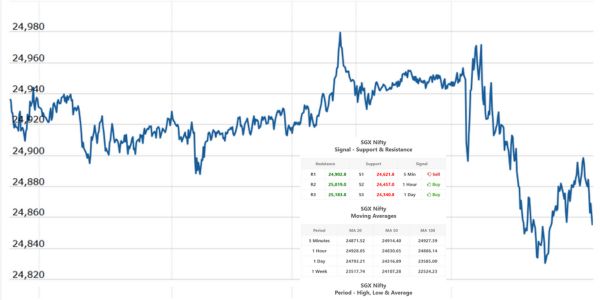Understand GIFT Nifty, India’s global futures market. Learn how to trade Nifty futures and its role in the Indian stock market for better investment decisions.
GIFT Nifty, a futures contract tied to the Nifty 50 Index, is traded in GIFT City, Gujarat, on the NSE International Exchange. It enables global investors to predict or hedge against movements in India’s stock market.
What Is GIFT Nifty?
GIFT Nifty is a futures contract based on the Nifty 50 Index, which tracks the top 50 companies on India’s National Stock Exchange. Launched on July 3, 2023, it replaced the SGX Nifty, previously traded in Singapore. Hosted in GIFT City, India’s first International Financial Services Centre, GIFT Nifty reflects global sentiment about India’s stock market, signaling how the Nifty 50 might open based on events like US economic data or geopolitical developments.
For instance, on May 12, 2025, GIFT Nifty traded at a 485-point premium, indicating a strong Nifty 50 opening due to positive US-China trade talks. On April 7, 2025, an 875-point drop foreshadowed a weak market start amid global recession fears. This makes GIFT Nifty essential for stock market predictions.
The Move from SGX Nifty to GIFT Nifty
The SGX Nifty enabled global investors to trade Nifty 50 futures for over two decades. In 2023, trading shifted to GIFT City, redirecting an estimated $7.5 billion in trading volume to India. This strengthened India’s financial oversight, created jobs, and elevated GIFT City as a GIFT City financial hub competing with global centers. The NSE International Exchange now hosts GIFT Nifty, advancing India’s global financial index ambitions.
Must Read: Investment Strategies for Navigating the Indian Stock Market
How GIFT Nifty Functions
GIFT Nifty is a derivative product whose value derives from the Nifty 50 Index. Traded in US dollars, it’s accessible to global investors. Unlike the National Stock Exchange’s 9:15 AM to 3:30 PM IST hours, GIFT Nifty operates nearly 21 hours daily across two sessions: 6:30 AM to 3:40 PM IST and 4:35 PM to 2:45 AM IST (next day). This allows trading in response to global events, such as US tariff changes or Asian market shifts.
GIFT Nifty serves as:
- A market indicator: A 50-point drop at 24,789 on May 29, 2025, signaled a cautious Nifty 50 opening due to US deficit concerns.
- A hedging tool: Institutional investors use it to shield portfolios from volatility.
- A speculation platform: Traders bet on short-term moves, enhancing liquidity in Indian equity derivatives.
Contracts like GIFT Nifty Bank, GIFT Nifty IT, and GIFT Nifty Midcap 50 expand its scope.
Why GIFT Nifty Is Significant
GIFT Nifty influences the Indian stock market by:
- Forecasting Trends: It reflects global views, impacting sectors like IT or banking.
- Enhancing Liquidity: Centralized trading in GIFT City improves market efficiency.
- Attracting Investment: Its US dollar denomination draws foreign institutional investors and NRIs.
- Guiding Strategies: Its movements, like during the 2020 COVID-19 recovery, shape investor confidence.
Benefits of GIFT Nifty
GIFT Nifty offers:
- Market Insights: Early signals of Nifty 50 trends before trading begins.
- Tax Advantages: GIFT City’s status avoids Securities Transaction Tax and Capital Gains Tax.
- Global Accessibility: Long hours and dollar-based trading suit international investors.
- Hedging Options: Protection against market volatility India.
Risks to Consider
Trading GIFT Nifty involves:
- Global Sensitivity: Events like US-China trade tensions or monetary policy shifts can trigger swings.
- Speculative Volatility: Extended hours invite risky bets, increasing fluctuations.
- Regulatory Nuances: GIFT City’s rules require careful navigation.
How to Trade GIFT Nifty
GIFT Nifty trading is designed for foreign investors, NRIs, and institutional traders, as Indian retail investors face restrictions under regulations limiting offshore leveraged investments to $250,000 annually. Here’s how to trade:
- Select a Broker: Choose a registered broker, such as those operating in GIFT City, with over 50 firms available.
- Open an Account: Submit KYC documents like a passport, visa, PAN card, or overseas address proof.
- Fund in Foreign Currency: Deposit US dollars or another foreign currency, as rupees are not permitted.
- Analyze Trends: Monitor global factors like US economic data or geopolitical news. Track GIFT Nifty’s sessions: 6:30 AM to 3:40 PM IST and 4:35 PM to 2:45 AM IST.
- Execute Trades: Trade contracts like GIFT Nifty 50 or GIFT Nifty Bank via your broker’s platform. The minimum contract size is 50 lots (e.g., ₹1,000,000 at ₹20,000 per index point).
- Mitigate Risks: Use stop-loss orders, diversify, and follow market updates to navigate volatility.
- Monitor Prices: Check real-time data on trading platforms or financial news outlets.
Indian retail investors can use GIFT Nifty trends to inform Nifty 50 futures trades on the National Stock Exchange or make stock market predictions.
Must Read: Regulatory Framework of the Indian Stock Market
GIFT Nifty vs. SGX Nifty
| Aspect | SGX Nifty | GIFT Nifty |
|---|---|---|
| Platform | Singapore Exchange | NSE International Exchange, GIFT City |
| Regulation | Singapore Authorities | IFSC Authority, SEBI |
| Currency | US Dollars | US Dollars |
| Trading Hours | 6:30 AM to 11:30 PM IST | 6:30 AM to 3:40 PM, 4:35 PM to 2:45 AM IST |
| Launch | September 2000 | July 3, 2023 |
GIFT Nifty builds on SGX Nifty’s framework with enhanced Indian oversight.
Why GIFT Nifty Matters
GIFT Nifty connects India’s stock market to global finance. Its movements, like a 485-point premium or an 875-point drop, impact stocks, mutual funds, and investor sentiment. Understanding GIFT Nifty equips you to navigate market volatility India, track Indian equity derivatives, and appreciate India’s growing financial influence. Whether trading or observing, GIFT Nifty is a key market driver.

